
Air Canada walks back new seat selection policy change after backlash
Air Canada has paused a new seat selection fee for travellers booked on the lowest fares just days after implementing it.
King Charles III will be reusing historic items of clothing, worn by previous monarchs at their own ceremonies, as he is crowned Saturday at his coronation in London's Westminster Abbey, a nod to the symbolism dating back 1,000 years while highlighting his interest in "sustainability and efficiency."
"There's kind of a nod to the past and the continuity of the institution. But there's also this kind of attempt to bring in this new way … and the focus on the natural world which is important, both to the King and Queen," CTV royal commentator Richard Berthelsen told CTVNews.ca.
The King will reuse vestments used in the coronations of King George IV in 1821, King George V in 1911, King George VI in 1937 and Queen Elizabeth II in 1953, Buckingham Palace confirmed this week.
The supertunica, which is customarily reused, is a full-length, sleeved gold coat, which is worn under the imperial mantle.
It was made for the coronation of King George V, and has been worn even more recently by Queen Elizabeth II in 1953 at her coronation.
Although it was made in 1911, the design has changed little since ancient ceremonies, based on the fashion of priestly and other religious vestments from medieval times.
The monarch is invested with the supertunica after the anointing. It will be fastened with the coronation sword belt.
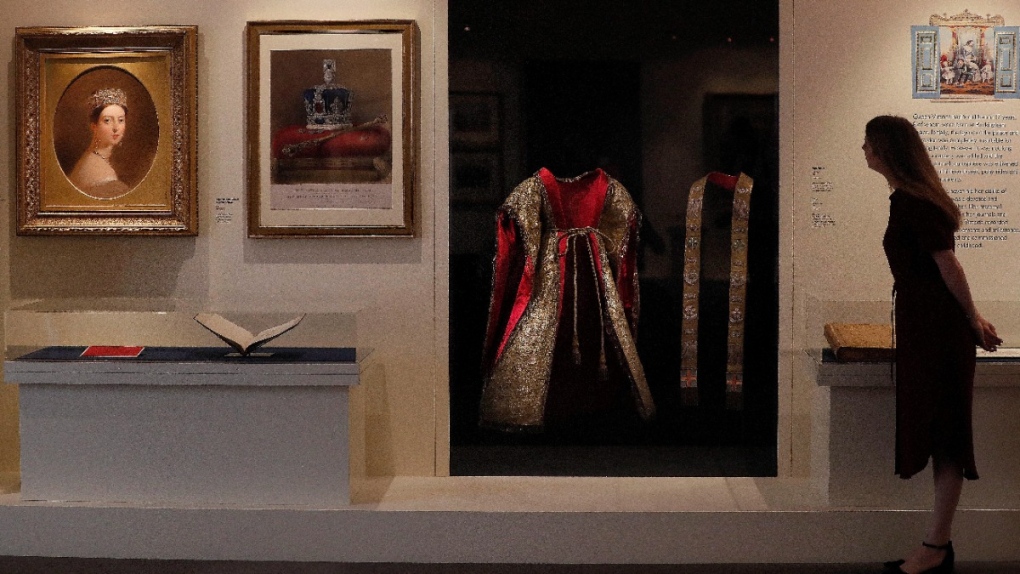 A woman looks at the Supertunica in an exhibition at Buckingham Palace, in London, on July 17, 2019. (Frank Augstein / AP)
A woman looks at the Supertunica in an exhibition at Buckingham Palace, in London, on July 17, 2019. (Frank Augstein / AP)
The imperial mantle, which was made in 1821, is made of cloth of gold, gold, silver and silk thread, silk, gold bullion fringe and a gold clasp. It is the oldest piece of clothing that's being used at this coronation.
The King will also reuse the colobium sindonis, coronation sword belt and coronation glove worn by his grandfather King George VI.
The colobium sindonis, a white linen shift-like tunic that has a plain collar fastened with a single button, is meant to represent a priest's alb, or white garment that comes down to the ankles.
The King will use the one worn at his grandfather's coronation in 1937.
The coronation sword belt is made of cloth of gold, and embroidered in gold thread, and lined in dark red silk, with a gold buckle and gold clip meant to attach the jewelled sword of offering.
Historically, a new sword belt is supplied for each coronation. However, once again the King has chosen to use the one created for his grandfather, King George VI, after undergoing some minor conservation by the Royal School of Needlework.
 The Coronation Gauntlet glove and Sword Belt, which form part of the Coronation Vestments, are displayed in the Throne Room at Buckingham Palace on May 1, 2023 in London, England. The vestments will be worn by King Charles III during his coronation at Westminster Abbey on May 6. (Photo by Victoria Jones-Pool/Getty Images)
The Coronation Gauntlet glove and Sword Belt, which form part of the Coronation Vestments, are displayed in the Throne Room at Buckingham Palace on May 1, 2023 in London, England. The vestments will be worn by King Charles III during his coronation at Westminster Abbey on May 6. (Photo by Victoria Jones-Pool/Getty Images)
The sword of offering is fastened to the sovereign's waist using the sword belt, at which point the sword will be passed to the King.
The Archbishop will present the sword to the monarch while saying that it should be used for the protection of good and the punishment of evil, Buckingham Palace explained.
Meanwhile the King will also reuse the coronation glove, or gauntlet, first used by his grandfather. It is meant to hold the sceptre during the crowning.
Made of white leather, and embroidered with gilt metal thread, wire and spangles, it is lined with red satin. Lord Indarjit Singh of Wimbledon will be presenting the King with the glove at the coronation.
It's quite unusual to reuse vestments, Berthelsen said, however, "things have been carefully preserved over the years. particularly in the last century, where preservation techniques were better. They didn't become moth-eaten and stuff like that. … So it's possible for them to do that where it wasn't before."
Meanwhile, new images released ahead of the coronation provided a glimpse of the two sets of robes the King and Queen will be wearing for the ceremony, in keeping with tradition.
The King's Robe of State, which he will wear on arrival, is made of crimson velvet. King George VI, Charles' grandfather, wore it at his coronation in 1937.
The Royal School of Needlework conserved the velvet while the lining and gold lace was conserved by London's oldest tailor Ede and Ravenscroft, which has made garments for every coronation since 1689.
The Queen's Robe of State, to be worn on arrival, was originally made for Queen Elizabeth II, her mother-in-law, in 1953.
It is also made of crimson velvet and robemakers at Ede and Ravenscroft have conserved the garment with adjustments.
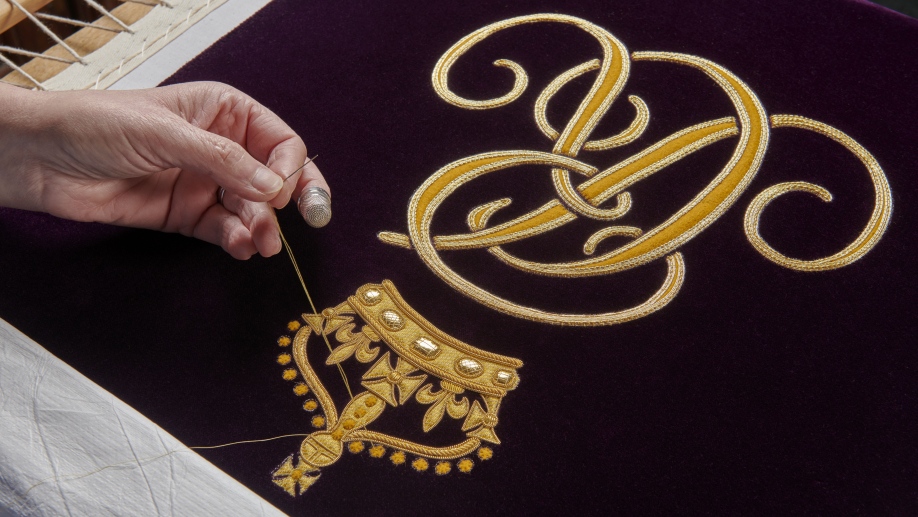 The Queen Consort’s new Robe of Estate being worked on by the Royal School of Needlework. (Royal Family)
The Queen Consort’s new Robe of Estate being worked on by the Royal School of Needlework. (Royal Family)
On departure, the King will wear the Robe of Estate worn by King George VI in 1937. Made of purple silk velvet embroidered in gold, robemakers at Ede and Ravenscroft conserved and prepared the robe in preparation.
The Royal School of Needlework also designed and hand embroidered the Queen Consort's purple velvet Robe of Estate while the robe itself was made by Ede and Ravenscroft.
The design of the train "draws on the themes of nature and the environment, featuring the national emblems of the United Kingdom, as well as paying tribute to His Majesty The King," the statement reads, "with the design also incorporating Her Majesty's cypher."
Drawing on the themes of nature and the environment, reflecting the King and Queen's "affection for the natural world":
"Fundamentally the King and Queen are both country people at heart. … They love to be outdoors, walking around and hiking and, you know, observing the natural world. I think it's much broader than just being environmentally conscious. I think it's actually kind of very important to them," Berthelsen said.
The photos show the Royal School of Needlework's embroidery team conserving The King's Robe of State, which he will wear on arrival at Westminster Abbey, as well as the Queen Consort's Robe of Estate, which will be worn after she is crowned, on departure from Westminster Abbey.
In 2017, as Duchess of Cornwall, Queen Consort Camilla became the patron of the school, which is renowned for its work for coronations throughout history, including for Queen Elizabeth II.
King Charles III will be crowned with St. Edward's Crown, one of the iconic symbols of the British monarchy, which was created for the coronation of Charles II in 1661. The crown was quietly removed from the Tower of London last December to be resized for the monarch.
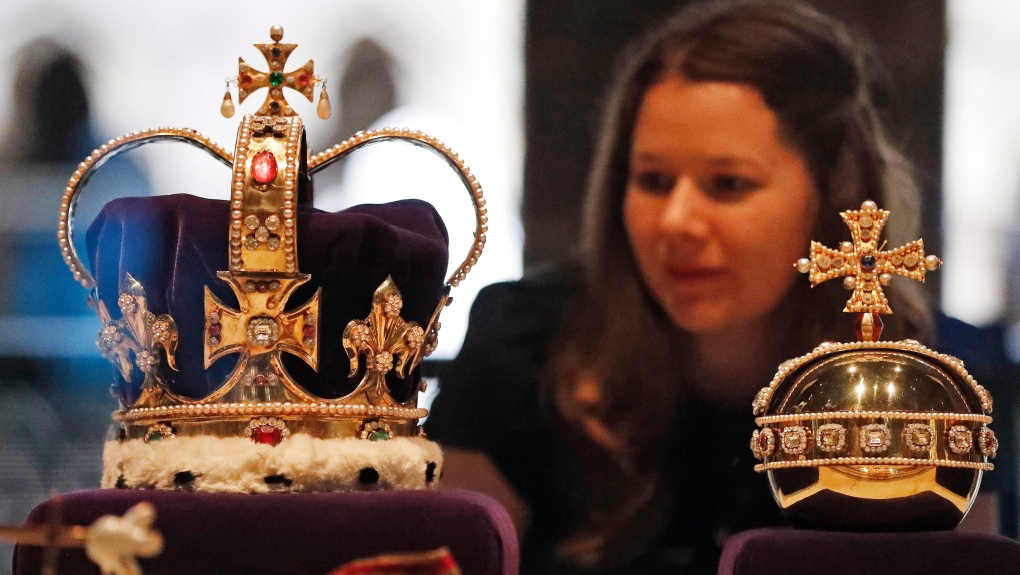 A woman looks at the St. Edward's Crown and Orb, part of an exhibition at the The Queen's Diamond Jubilee Galleries, in Westminster Abbey, in London, Tuesday, May 29, 2018. (AP Photo/Frank Augstein)
A woman looks at the St. Edward's Crown and Orb, part of an exhibition at the The Queen's Diamond Jubilee Galleries, in Westminster Abbey, in London, Tuesday, May 29, 2018. (AP Photo/Frank Augstein)
Topped with an orb and a cross, the 2.2-kilogram crown has a purple velvet cap with an ermine band and is made up of a solid gold frame, set with rubies, amethysts, sapphires, garnet, topazes and tourmalines.
The King will switch to the lighter Imperial State Crown at the end of the ceremony for the procession back to the palace.
The regalia the King will be invested with also includes the gem-encrusted orb and sceptres, which date back to 1661.
The orb, a golden ball topped by a jewelled cross, will be placed in the right hand of the monarch as he is invested.
"Now, the orb is something that reflects the fact that the king … is the sovereign of the country. And there's a cross on top of it, which reflects the fact that he's a Christian sovereign," Berthelsen said.
It was made from gold in the seventeenth century and "is divided into three sections with bands of jewels, for each of the three continents known in medieval period," the Palace said.
The King will also be presented with two sceptres, meant to represent the Crown's power and governance. One will be surmounted by a cross while the other is surmounted by a dove, representing the Holy Ghost.
The orb and sceptres remain with the monarch until the very last minute, Berthelsen said. And their removal marks the end of their reign. "So they're very, very important from that point of view."
The King will also be wearing a ring comprising a sapphire with a ruby cross set in diamonds. Dubbed the Sovereign's Ring, it was made for the coronation of King William IV in 1831 and all sovereigns from then onwards have used it at their ceremonies.
Meanwhile, Queen Consort Camilla will be wearing Queen Mary's Crown, which was commissioned by Charles' great-grandmother, Mary, for her husband King George V's 1911 coronation. This marks the first time in modern history that an existing crown is being used for the coronation of the consort, according to the palace. Minor changes and additions will be made to the crown, including adding diamonds that were part of Queen Elizabeth II's personal jewelry collection.
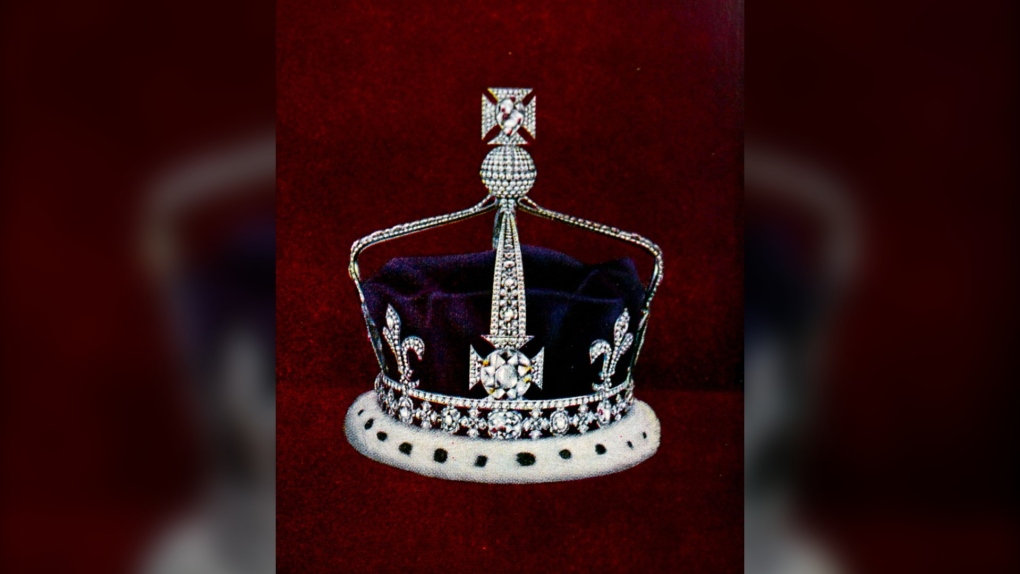 State Crown of Queen Mary of Teck (1867-1953), Consort of King George V. Manufactured for the coronation of George and Mary. Dated 20th Century. (Photo by Universal History Archive/Universal Images Group via Getty Images)
State Crown of Queen Mary of Teck (1867-1953), Consort of King George V. Manufactured for the coronation of George and Mary. Dated 20th Century. (Photo by Universal History Archive/Universal Images Group via Getty Images)
"Using these crowns is a good idea because they are less controversial, they don't contain diamonds and jewels that have a dubious history," royal commentator Afua Hagan said.
Camilla's choice means she avoids the controversy surrounding another crown featuring the Koh-i-Noor diamond. India has demanded the return of the disputed 106-carat diamond.
However Camilla's choice of spectre is not without controversy, as it's made of ivory. Prince William has campaigned against illegal animal part trafficking and there was some speculation leading up to the coronation that she'd avoid it for that reason.
The Queen Consort will also be wearing on her hand a ring that has a ruby in a gold setting, dating back to the coronation of King William IV and Queen Adelaide in 1831. It has been used by three further Queens Consort: Queen Alexandra, Queen Mary, and Queen Elizabeth The Queen Mother.
While the Prince and Princess of Wales' outfits have not been revealed, royal-watchers wondered if there were clues in the matching royal blue hues worn by Kate Middleton and Queen Consort Camilla for Easter Sunday.
The Prince and Princess of Wales "will take their cue from the King and Queen because they are the obviously the next most important people and all eyes will definitely be on them. Because they are next," said Berthelsen, adding "All eyes will be on them because this will be them in 20 years' time."
It's expected that Prince William will wear a military uniform and that Catherine will be wearing a tiara, Berthelsen said.
While his grandmother liked to see him in his uniform a colonel of the guards, a red uniform, William likes to wear the Air Force uniform as that's where he served, Berthelsen said.
As Berthelsen pointed out, the invitations published online by Buckingham Palace did not mention a dress code, although these would have been seen as keepsakes and invited guests likely would have received guidance on their dress for the coronation.
However, the Telegraph reported that peers attending the event have been asked to dress down with the aim to match the monarch's desire for a more pared-back ceremony.
"It will be much less elaborate than the last coronation. It's going to be a very dressy occasion, obviously," Berthelsen said, "But it's not going to be anywhere to the magnitude of what we saw in '53."
The dress code for guests invited to the congregation is reportedly morning dress, which means in simpler terms, to dress as if they're going to a wedding, Hagan explained.
"Royals will be coming from different places, we can expect to see them wearing their finery, their tiaras, their gowns. It will have a wedding feel," she told CTVNews.ca.
Hats and fascinators, a long-time British tradition, will certainly be a part of coronation fashion as guests dress up in their finest.
Milliner Rachel Trevor-Morgan, who was Queen Elizabeth's milliner since 2006, and has held the royal warrant since 2014, says we can expect to see guests wearing her hats at the coronation, although she can't share who they might be.
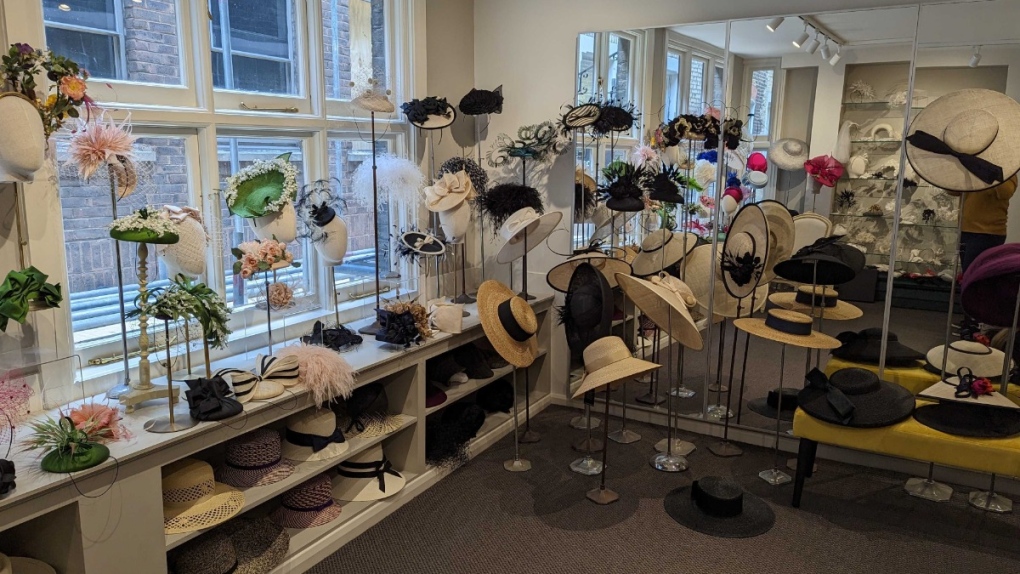 Inside Milliner Rachel Trevor-Morgan's St. James atelier, in London. (Mary Nersessian / CTV News)
Inside Milliner Rachel Trevor-Morgan's St. James atelier, in London. (Mary Nersessian / CTV News)
As she gestures at the handmade creations in her chic St. James's atelier, steps from Buckingham Palace, Trevor-Morgan says the disc-shaped hats are certainly still popular as they're easy to wear, and easy to dress up or down, as are the pillbox hats, made famous by Jackie Onassis.
In terms of coronation etiquette, "you don't want to go along to the coronation with a particularly showy hat.
"I would say it's a celebration so you want to be in a celebratory mode but you don't want to wear something that is too over-the-top or will draw too much attention," she said.
She's also noticed clients becoming very conscious of the people who may be seated around them.
"You don't want to wear an enormous hat so no one around you can see what's going on," said Trevor-Morgan, whose hats have been photographed being worn by Catherine Middleton, the Princess of Wales, although she politely responded that that "was a long time ago."
All eyes will be on Westminster Abbey's doors as the important guests are expected to arrive at the coronation between 9:30 a.m. and 10:45 a.m. local time, including heads of state, ministers, government representatives, members of the Royal Family and foreign royals.

Air Canada has paused a new seat selection fee for travellers booked on the lowest fares just days after implementing it.
An ongoing municipal strike, court battles and revolt by half of council has prompted the province to oust the mayor and council in Black River-Matheson.
Three officers on a U.S. Marshals Task Force serving a warrant for a felon wanted for possessing a firearm were killed and five other officers were wounded in a shootout Monday at a North Carolina home, police said.
A Calgary elementary school principal has been charged with possession of child pornography, authorities announced Monday.
The Vancouver Island Health Authority is downplaying what staff describe as a cockroach infestation in a medical unit of Saanich Peninsula Hospital.
Toronto police say 12 people are facing a combined 102 charges in connection with an investigation into a major credit fraud scheme.
One of the winners of a historic US$1.3 billion Powerball jackpot last month is an immigrant from Laos who has had cancer for eight years and had his latest chemotherapy treatment last week.
Britney Spears and her father Jamie Spears will avoid what could have been a long, ugly and revealing trial with a settlement of the lingering issues in the court conservatorship that controlled her life and financial decisions for nearly 14 years.
The clock is ticking ahead of the deadline to file a 2023 income tax return. A personal finance expert explains why you should get them done -- even if you owe more than you can pay.

Since 1932, Montreal's Henri Henri has been filled to the brim with every possible kind of hat, from newsboy caps to feathered fedoras.
Police in Oak Bay, B.C., had to close a stretch of road Sunday to help an elephant seal named Emerson get safely back into the water.
Out of more than 9,000 entries from over 2,000 breweries in 50 countries, a handful of B.C. brews landed on the podium at the World Beer Cup this week.
Raneem, 10, lives with a neurological condition and liver disease and needs Cholbam, a medication, for a longer and healthier life.
The lawyer for a residential school survivor leading a proposed class-action defamation lawsuit against the Catholic Church over residential schools says the court action is a last resort.
Mounties in Nanaimo, B.C., say two late-night revellers are lucky their allegedly drunken antics weren't reported to police after security cameras captured the men trying to steal a heavy sign from a downtown business.
A property tax bill is perplexing a small townhouse community in Fergus, Ont.
When identical twin sisters Kim and Michelle Krezonoski were invited to compete against some of the world’s most elite female runners at last week’s Boston Marathon, they were in disbelief.
The giant stone statues guarding the Lions Gate Bridge have been dressed in custom Vancouver Canucks jerseys as the NHL playoffs get underway.